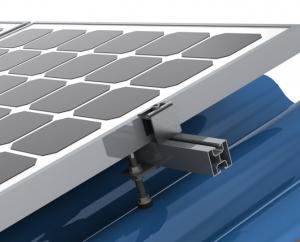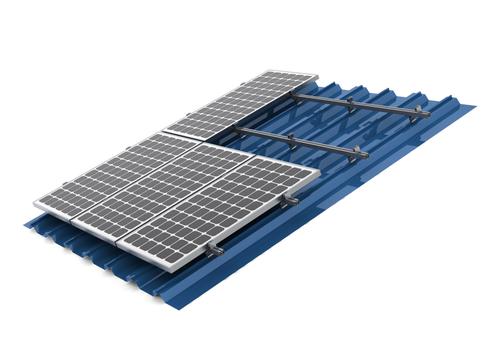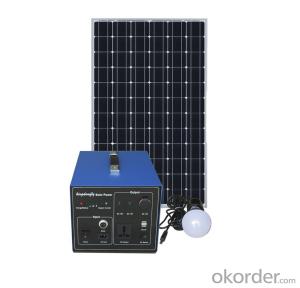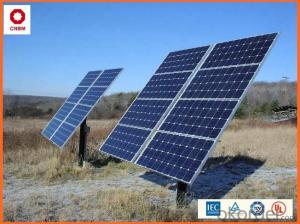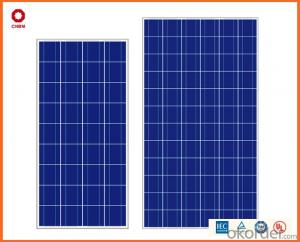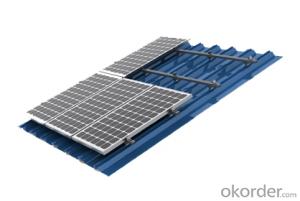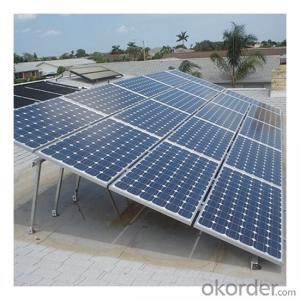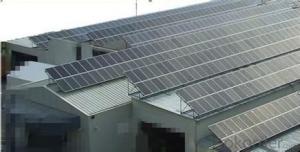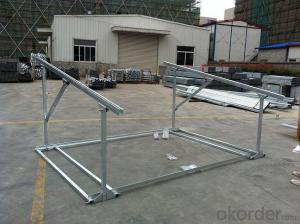Scudder Solar Energy Systems Solar Mounting Metal Sheet Roof System
- Loading Port:
- China Main Port
- Payment Terms:
- TT or LC
- Min Order Qty:
- -
- Supply Capability:
- -
OKorder Service Pledge
OKorder Financial Service
You Might Also Like
Product Features
• Less piece of components and easy for installation.
• Design speical clamp matching to the metal sheet shape and specification.
• Use super quality Al-alloy and stainless steel for components.
• Wide range of product line .
Technical Data
Installation site Metal sheet roof
Slope of roof Client requirement
Module specification Frame / frameless module, crystalline/thin film module
Installation type Parallel to the roof
Module arrangement Portrait Landscape
Module area square Client requirement
Module area position Client requirement
Roof structure Client requirement
Loading section Al 6063 T5
Small pieces Stainless steel, Al6063 T5
- Q: Can solar energy systems be used for powering irrigation systems?
- Yes, solar energy systems can be used to power irrigation systems. Solar panels can generate electricity that can be used to power pumps and other equipment needed for irrigation. This can provide a sustainable and cost-effective solution for farmers and agricultural operations.
- Q: What are the maintenance costs associated with solar energy systems?
- The maintenance costs associated with solar energy systems are generally low compared to other forms of energy generation. Solar panels themselves require very little maintenance as they have no moving parts. However, there are a few key components that may require periodic maintenance or replacement. One of the main maintenance costs is the cleaning of solar panels. Over time, dust, dirt, and debris can accumulate on the surface of the panels, reducing their efficiency. Regular cleaning, typically done with water or a soft brush, helps ensure optimal energy production. Another maintenance cost is the inspection and repair of electrical connections and wiring. These components are essential for converting the sun's energy into usable electricity. Regular inspections can identify any loose connections or damaged wiring that may hinder the system's performance. In addition, inverters, which convert the direct current (DC) generated by the solar panels into alternating current (AC) used in homes and businesses, may need to be replaced after a certain lifespan. Inverter replacement is typically required every 10-15 years, depending on the manufacturer and usage. Overall, the maintenance costs for solar energy systems are relatively minimal compared to the long-term savings and benefits they provide. It is recommended to have a professional solar installer or technician perform regular inspections and maintenance to ensure the system operates efficiently and maximizes its lifespan.
- Q: Can solar energy systems be used in areas with strict noise regulations?
- Yes, solar energy systems can be used in areas with strict noise regulations. Solar energy systems are typically silent as they do not have any moving parts, unlike traditional power generation systems such as generators. Therefore, they comply with noise regulations and can be installed and operated without causing any noise disturbances.
- Q: Can solar energy systems be used for powering remote communication systems?
- Yes, solar energy systems can be used for powering remote communication systems. Solar panels can convert sunlight into electricity, which can then be stored in batteries for later use. This makes solar energy a reliable and sustainable source of power for remote communication systems, eliminating the need for traditional grid connections or fuel-powered generators. Additionally, solar energy systems can be designed to withstand harsh weather conditions and operate in remote locations, making them an ideal solution for powering communication systems in remote areas.
- Q: Can solar energy systems be used in areas with limited access to electricity grids?
- Yes, solar energy systems can be effectively used in areas with limited access to electricity grids. Solar panels can be installed in such areas to harness sunlight and convert it into electricity, eliminating the need for connection to traditional power grids. This enables communities and individuals to access clean and renewable energy, powering their homes, businesses, and other activities. Additionally, solar energy systems can be combined with energy storage solutions, such as batteries, to store excess energy for use during nighttime or cloudy periods, further ensuring a reliable and continuous power supply.
- Q: How do solar energy systems impact the demand for traditional energy sources?
- Solar energy systems have a significant impact on the demand for traditional energy sources. As more and more solar panels are installed and integrated into the power grid, the reliance on fossil fuels decreases. This is because solar energy systems generate electricity directly from sunlight, eliminating the need for traditional energy sources such as coal, oil, and natural gas. The increased adoption of solar energy systems reduces the demand for traditional energy sources in several ways. Firstly, solar power can be produced locally, reducing the need for long-distance transmission of electricity from power plants. This reduces transmission losses and the associated costs, making solar energy more economically viable. Secondly, solar energy systems generate electricity during daylight hours when demand is typically high, especially in residential and commercial settings. This reduces the strain on traditional energy sources during peak demand periods, which can help stabilize the power grid and prevent blackouts or shortages. Furthermore, the integration of solar energy systems into the power grid allows for excess electricity to be fed back into the grid. This surplus energy can be used by other consumers, reducing the overall demand for traditional energy sources. This concept, known as net metering, not only reduces the reliance on traditional energy sources but also incentivizes the adoption of solar energy systems. Overall, the widespread use of solar energy systems has a positive impact on the demand for traditional energy sources. It reduces the need for fossil fuels, promotes energy independence, and contributes to the global transition towards clean and renewable energy sources. However, it is important to note that complete replacement of traditional energy sources with solar energy is not feasible in all situations, and a balanced energy mix is still necessary to meet the diverse energy demands of society.
- Q: How do solar energy systems impact the energy poverty gap?
- Solar energy systems have the potential to significantly reduce the energy poverty gap by providing affordable and sustainable electricity to those who lack access to traditional energy sources. These systems empower communities to generate their own clean energy, enabling them to break free from reliance on expensive and polluting fuels. Moreover, solar energy can be harnessed in remote and off-grid areas, reaching populations that are often neglected by traditional energy infrastructure. By bridging the energy poverty gap, solar energy systems contribute to socio-economic development, improve living conditions, and enhance opportunities for education, healthcare, and economic growth in underserved communities.
- Q: How do solar energy systems impact water resources?
- Solar energy systems have a positive impact on water resources as they do not require water for their operation, unlike traditional energy sources such as coal or nuclear power plants. This helps in conserving water, which is a precious resource, and reduces the strain on water supplies. Additionally, solar energy systems can be utilized to power water treatment plants, enhancing access to clean and safe water in remote areas.
- Q: Can solar energy systems be installed on camping sites?
- Yes, solar energy systems can be installed on camping sites. In fact, solar panels are commonly used to power camping equipment such as lights, portable chargers, and even small appliances. They are a sustainable and convenient solution for accessing electricity in remote locations without the need for traditional power sources.
- Q: Can solar energy systems be used in rural areas without access to the grid?
- Solar energy systems are definitely able to be utilized in rural areas that lack access to the grid. In reality, solar power can serve as an ideal solution for off-grid locations as it captures energy from the sun and converts it into electricity without relying on conventional power sources. Sunlight can be captured by installing solar panels on rooftops or in open spaces, which can then be converted into usable electricity through an inverter system. This electricity can be utilized to power a wide range of appliances and devices, providing electricity for lighting, charging mobile phones, operating small appliances, and even powering agricultural equipment or water pumps. Furthermore, any excess energy generated during the day can be stored in batteries for use during nighttime or overcast days. Solar energy systems present a sustainable and dependable electricity source for rural communities, decreasing their reliance on costly and unreliable generators that run on fossil fuels or traditional power grids.
Send your message to us
Scudder Solar Energy Systems Solar Mounting Metal Sheet Roof System
- Loading Port:
- China Main Port
- Payment Terms:
- TT or LC
- Min Order Qty:
- -
- Supply Capability:
- -
OKorder Service Pledge
OKorder Financial Service
Similar products
Hot products
Hot Searches
Related keywords



